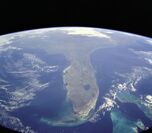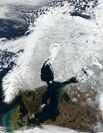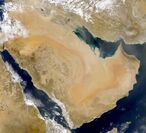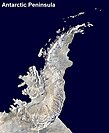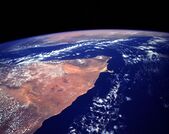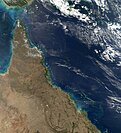Earth:Peninsula
A peninsula (from la paeninsula; from paene 'almost', and insula 'island')[1][2] is a landform that extends from a mainland and is surrounded by water on most, but not all of its borders.[3][4][5] A peninsula is also sometimes defined as a piece of land bordered by water on three of its sides.[3][6] Peninsulas exist on all continents.[7][2] The size of a peninsula can range from small to very large.[7] The largest peninsula in the world is the Arabian Peninsula.[8][9] Peninsulas form due to a variety of causes.
Etymology
Peninsula derives from la paeninsula, which is translated as 'peninsula'. Paeninsula itself was derived from paene 'almost', and insula 'island', or together, 'almost an island'.[3] The word entered English in the 16th century.[3]
Definitions
A peninsula is usually defined as a piece of land surrounded on most, but not all sides, by water,[5] but is sometimes instead defined as a piece of land bordered by water on three of its sides.[6]
A peninsula may be bordered by more than one body of water, and the body of water does not have to be an ocean or a sea.[10] A piece of land on a very tight river bend or one between two rivers is sometimes said to form a peninsula, for example in the New Barbadoes Neck in New Jersey, United States.[5] A peninsula may be connected to the mainland via an isthmus, for example, in the Isthmus of Corinth which connects to the Peloponnese peninsula.[11]
Formation and types
Peninsulas can be formed from continental drift, glacial erosion, glacial meltwater, glacial deposition, marine sediment, marine transgressions, volcanoes, divergent boundaries or river sedimentation.[12] More than one factor may play into the formation of a peninsula. For example, in the case of Florida, continental drift, marine sediment, and marine transgressions were all contributing factors to its shape.[13]
Glaciers
In the case of formation from glaciers (e.g., the Antarctic Peninsula or Cape Cod), peninsulas can be created due to glacial erosion, meltwater or deposition.[14] If erosion formed the peninsula, softer and harder rocks were present, and since the glacier only erodes softer rock, it formed a basin.[14] This may create peninsulas, and occurred for example in the Keweenaw Peninsula.[14]
In the case of formation from meltwater, melting glaciers deposit sediment and form moraines, which act as dams for the meltwater.[14] This may create bodies of water that surround the land, forming peninsulas.[14]
If deposition formed the peninsula, the peninsula was composed of sedimentary rock, which was created from a large deposit of glacial drift.[15][16] The hill of drift becomes a peninsula if the hill formed near water but was still connected to the mainland, for example during the formation of Cape Cod about 23,000 years ago.[17][18]
Others
In the case of formation from volcanoes, when a volcano erupts magma near water, it may form a peninsula (e.g., the Alaskan Peninsula).[15] Peninsulas formed from volcanoes are especially common when the volcano erupts near shallow water.[19] Marine sediment may form peninsulas by the creation of limestone.[20] A rift peninsula may form as a result of a divergent boundary in plate tectonics (e.g. the Arabian Peninsula),[21][22] while a convergent boundary may also form peninsulas (e.g. Gibraltar or the Indian subcontinent).[23] Peninsulas can also form due to sedimentation in rivers. When a river carrying sediment flows into an ocean, the sediment is deposited, forming a delta peninsula.[24]
Marine transgressions (changes in sea level) may form peninsulas, but also may affect existing peninsulas. For example, the water level may change, which causes a peninsula to become an island during high water levels.[25] Similarly, wet weather causing higher water levels make peninsulas appear smaller, while dry weather make them appear larger.[26] Sea level rise from global warming will permanently reduce the size of some peninsulas over time.[27]
Uses
Peninsulas are noted for their use as shelter for humans and Neanderthals.[28] The landform is advantageous because it gives hunting access to both land and sea animals.[28] They can also serve as markers of a nation's borders.[29]
List of the largest peninsulas in the world
| Rank | Peninsula | Continent | Subregion | Part of | Area | Nation(s) | Source | |
|---|---|---|---|---|---|---|---|---|
| (km2) | (sq mi) | |||||||
| 1 | Arabian Peninsula | Asia | West Asia | Arabia | 3,100,000 | 1,200,000 | [30] | |
| 2 | Indochinese Peninsula | Asia | Southeast Asia | Mainland Southeast Asia | 2,000,000 | 770,000 | [31] | |
| 3 | Deccan Peninsula | Asia | South Asia | Indian Subcontinent | 1,900,000 | 730,000 | [32] | |
| 4 | Labrador Peninsula | North America | Northern America | – | 1,400,000 | 540,000 | [33] | |
| 5 | Anatolian Peninsula | Asia | West Asia | Asia Minor | 755,688 | 291,773 | [34] | |
| 6 | Scandinavian Peninsula | Europe | Northern Europe | Fennoscandia | 750,000 | 290,000 | [35] | |
| Somali Peninsula | Africa | East Africa | Horn of Africa | 750,000 | 290,000 | [36] | ||
| 8 | Balkan Peninsula | Europe | Southern Europe | South-eastern Europe | 666,700 | 257,400 | [37] | |
| 9 | Iberian Peninsula | Europe | Southern Europe | South-western Europe | 583,256 | 225,196 | [38] | |
| 10 | Antarctic Peninsula | Antarctica | West Antarctica | – | 522,000 | 202,000 | – | [39] |
| 11 | Taymyr Peninsula | Asia | North Asia | North Siberian Lowland | 400,000 | 150,000 | [40] | |
| 12 | Kamchatka Peninsula | Asia | North Asia | Russian Far East | 370,000 | 140,000 | [41] | |
See also
References
- ↑ "peninsula". Boston: Houghton Mifflin Harcourt. 2014. https://www.ahdictionary.com/word/search.html?q=peninsula.
- ↑ 2.0 2.1 Nadeau 2006, p. 5.
- ↑ 3.0 3.1 3.2 3.3 HMH 2004, p. 216.
- ↑ "Definition of peninsula". Cambridge Dictionaries Online. Cambridge University Press. http://dictionary.cambridge.org/dictionary/english/peninsula.
- ↑ 5.0 5.1 5.2 Kersey, Paul (23 July 2021). "What is a Peninsula?" (in en). https://www.infoplease.com/world/geography/what-is-a-peninsula.
- ↑ 6.0 6.1 "list of peninsulas" (in en). https://www.britannica.com/topic/list-of-peninsulas-2024442.
- ↑ 7.0 7.1 Society, National Geographic (2011-01-21). "peninsula" (in en). http://www.nationalgeographic.org/encyclopedia/peninsula/.
- ↑ Mis 2009, p. 20.
- ↑ Niz 2006, p. 19.
- ↑ Heos 2010, p. 15.
- ↑ Heos 2010, p. 9.
- ↑ Mis 2009, p. 6.
- ↑ Heos 2010, p. 8.
- ↑ 14.0 14.1 14.2 14.3 14.4 Heos 2010, p. 31.
- ↑ 15.0 15.1 Nadeau 2006, p. 6.
- ↑ Heos 2010, p. 32–33.
- ↑ Nadeau 2006, p. 9.
- ↑ Wyckoff 1999, p. 328.
- ↑ Heos 2010, p. 44.
- ↑ Heos 2010, p. 21–23.
- ↑ Nadeau 2006, p. 10.
- ↑ Heos 2010, pp. 43–44.
- ↑ Heos 2010, p. 40.
- ↑ Nadeau 2006, p. 13.
- ↑ Niz 2006, p. 7.
- ↑ Niz 2006, p. 13.
- ↑ Nadeau 2006, p. 21.
- ↑ 28.0 28.1 Heos 2010, p. 45.
- ↑ Heos 2010, p. 48.
- ↑ Encyclopædia Britannica: Arabia
- ↑ Polytheistic and Syncretic Religious Beliefs in Southeast Asia - Nature, Features, and Geographical Distribution
- ↑ Government of India - Ministry of Mines: Explore India
- ↑ WorldAtlas: Labrador Peninsula
- ↑ Turkey at a Glance
- ↑ Encyclopædia Britannica: Scandinavian Peninsula
- ↑ Africa’s largest peninsula has always been on the target of world powers. Where is it actually located?
- ↑ Encyclopædia Britannica: Balkans
- ↑ WorldAtlas: Iberian Peninsula
- ↑ Antarctic Peninsula Ice Sheet
- ↑ Encyclopædia Britannica: Taymyr Peninsula
- ↑ Encyclopædia Britannica: Kamchatka Peninsula
Bibliography
- Heos, Bridget (2010). The creation of peninsulas (1st ed.). New York: Rosen Pub. ISBN 978-1-4358-5301-0. OCLC 277466133. https://www.worldcat.org/oclc/277466133.
- Mis, Melody S. (2009). Exploring peninsulas (1st ed.). New York: PowerKids Press. ISBN 978-1-4358-2711-0. OCLC 230802567. https://www.worldcat.org/oclc/230802567.
- Nadeau, Isaac (2006). Peninsulas (1st ed.). New York: Rosen Pub. Group's PowerKids Press. ISBN 1-4042-3125-0. OCLC 57068647. https://www.worldcat.org/oclc/57068647.
- Niz, Ellen Sturm (2006). Peninsulas. Mankato, Minn.: Capstone Press. ISBN 0-7368-4308-6. OCLC 57366483. https://www.worldcat.org/oclc/57366483.
- Word Histories and Mysteries: From Abracadabra to Zeus. Houghton Mifflin Harcourt. 2004. ISBN 978-0547350271. OCLC 55746553. https://books.google.com/books?id=cZ88p_bSt1EC&pg=PA216.
- Wyckoff, Jerome (1999). Reading the earth : landforms in the making. Mahwah, NJ: Adastra West, Inc. ISBN 0-9674075-0-8. OCLC 43274886. https://www.worldcat.org/oclc/43274886.
External links
 |
